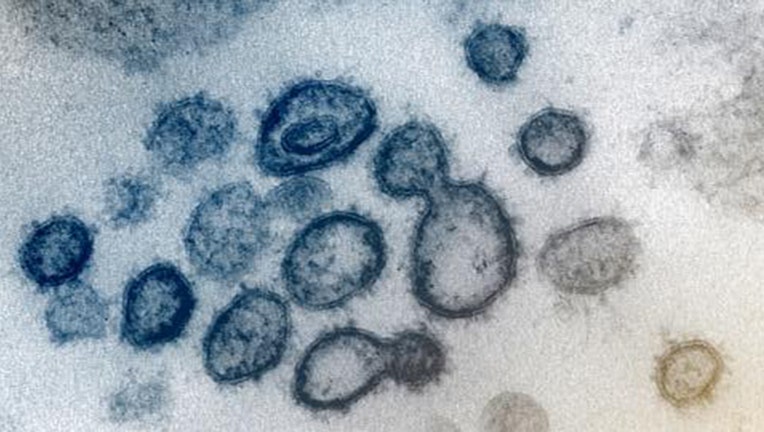Arizona reports nearly 2,000 COVID-19 cases, 22 deaths

A transmission electron microscope image shows SARS-CoV-2, also known as the 2019 novel coronavirus, which causes COVID-19, isolated from a patient in the United States. Note the crown-like spikes on the outer edge of the virus, hence the term "coron (NIAID-RML)
PHOENIX - Arizona on Nov. 6 reported nearly 2,000 additional known COVID-19 cases as the coronavirus outbreak continued to intensify.
The state Department of Health Services reported 1,996 additional cases with 22 deaths, increasing the state’s totals to 254,764 cases and 6,109 deaths.
The number of infections is thought to be far higher because many people have not been tested, and studies suggest people can be infected with the virus without feeling sick.
Arizona was a national hot spot in June and July. But conditions improved in August and most of September before COVID-19 cases and hospitalizations began to gradually increase, a trend that continued throughout October and into November.
COVID-19-related hospitalizations remain far below peak summer levels but topped 1,000 on Tuesday for the first time since late August. They stood at 1,082 as of Thursday.
State officials on Friday continued to urge Arizonans to heed health advice to wear masks, wash hands and socially distance.
State officials have said the outbreak is getting worse in the wake of partial reopenings of schools and businesses and that more spread is expected in the coming weeks due to social gatherings, including family get-togethers for Thanksgiving.
According to Johns Hopkins University data analyzed by The Associated Press, rolling seven-day averages for Arizona for new daily cases, daily deaths and testing positivity increased over the past two weeks,
The rolling average for daily new cases went from 880 on Oct. 22 to 1,470 on Thursday while the average for daily deaths rose from 10 to 24 and the average for testing positivity grew from 9.1% to 12.7%.
For most people, the new coronavirus causes mild or moderate symptoms, such as fever and cough that clear up in two to three weeks. For some, especially older adults and people with existing health problems, it can cause more severe illness, including pneumonia, and death. The vast majority of people recover.
In order to protect yourself from a possible infection, the CDC recommends:
- Avoid close contact with people who are sick.
- Avoid touching your eyes, nose, and mouth.
- Stay home when you are sick.
- Cover your cough or sneeze with a tissue, then throw the tissue in the trash.
- Clean and disinfect frequently touched objects and surfaces using a regular household cleaning spray or wipe.
- Cover your mouth and nose with a cloth face cover when around others
- Wash your hands often with soap and water for at least 20 seconds, especially after going to the bathroom; before eating; and after blowing your nose, coughing, or sneezing.
- Monitor your health daily
MAP: Worldwide interactive Coronavirus case data
MAP: Arizona Coronavirus cases by zip code
FULL COVERAGE: fox10phoenix.com/coronavirus
CDC: How coronavirus spreads, symptoms, prevention, treatment, FAQ
Arizona COVID-19 resources, FAQ: azdhs.gov/coronavirus
On CoronavirusNOW.com, you'll find extensive coverage about COVID-19, including breaking news from around the country, exclusive interviews with health officials, and informative content from a variety of public health resources.
RELATED:
- Coronavirus in Arizona: Latest case numbers
- Coronavirus: Symptoms, testing and how to prepare amid growing COVID-19 outbreak
- How coronavirus differs from flu: Symptoms to watch for
Symptoms for coronavirus COVID-19 include fever, coughing, and shortness of breath. These, of course, are similar to the common cold and flu.
Expect a common cold to start out with a sore or scratchy throat, cough, runny and/or stuffy nose. Flu symptoms are more intense and usually come on suddenly, and can include a high fever.
Symptoms of COVID-19 may appear more slowly. They usually include fever, a dry cough and noticeable shortness of breath, according to the World Health Organization. A minority of cases develop pneumonia, and the disease is especially worrisome for the elderly and those with other medical problems such as high blood pressure, obesity, diabetes or heart conditions.
RELATED: Is it the flu, a cold or COVID-19? Different viruses present similar symptoms
Right now there's one big difference between flu and coronavirus: A vaccine exists to help prevent the flu and it's not too late to get it. It won't protect you from catching the coronavirus, but may put you in a better position to fight it.
To protect yourself, wash your hands well and often, keep them away from your face, and avoid crowds and standing close to people.
And if you do find yourself showing any of these flu or coronavirus symptoms - don't go straight to your doctor's office. That just risks making more people sick, officials urge. Call ahead, and ask if you need to be seen and where.


